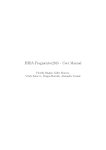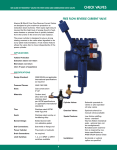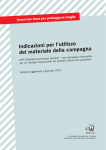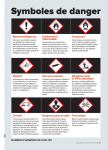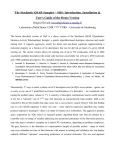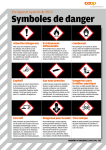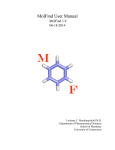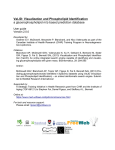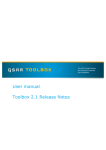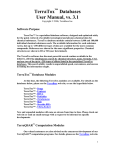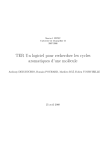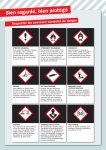Download ISIDA Fragmentor2011
Transcript
ISIDA Fragmentor2011 - User Manual
Gilles Marcou, Vitaly Solov’ev, Dragos Horvath, Alexandre Varnek
April 5, 2012
Chapter 1
Introduction
The ISIDA Fragmentor2011 is a development of the Laboratoire d’Infochimie, Institut de Chimie UMR 7177, Université de Strasbourg, France. This program is a
part of the ISIDA project, which stands for “In SIlico Design and data Analysis“
and aims to develop tools for the calculation of descriptors, the navigation in chemical space, quantitative structure-activity modeling (QSAR) and virtual screening.
The ISIDA Fragmentor2011 calculates molecular fragment count descriptors from a
Structure-Data File (SDF). It is based on a series of graph algorithm from the book
”Algorithmes de graphes“ [1].
The ISIDA descriptors have been described in 5 publications:
• ISIDA Substructural Molecular Fragments (SMF)[2, 3]
• ISIDA Fuzzy Pharmacophoric Triplets (FPT) [4, 5]
• ISIDA Property-Labelled Fragments (IPLF) [6]
ISIDA Fragmentor2011 is able to calculate SMF and IPLF (with a ChemAxon
based java program: CA_Prop_Map2011) as described in the publications. FPT
are not yet available through this program and require the use of an older java
program - Topo.java - based on ChemAxon plugins.
The laboratory uses the ChemAxon plugins to map a property on the graph.
However, one of the aims of ISIDA Fragmentor2011 is to enable the use of any
combination of options and let the user as much freedom as possible to fit his needs.
Therefore, the ”coloration“ of the molecular graph can be user-defined - given the
input format is respected.
The next Chapter describes all the options, input and output format description,
installation and usage of Fragmentor2011 and the corresponding nomenclature of
ISIDA fragment descriptors. Chapter 3 is dedicated to our ChemAxon-based property mapping program.
1
Chapter 2
Fragmentor2011
2.1
Command line
The ISIDA Fragmentor2011 is a command line only program. You may call upon
it using:
PATH/Fragmentor -i <SDFile> -o <BaseName>
[-f <string> -s <string> -h <HeaderFile>]
-t <integer> [{-l <integer> -u <integer>}
-c <SDField> -m <(0,1,2)> -d <(0,1,2)>
- -DoAllWays - -AtomPairs - -UseFormalCharge - -StrictFrg]
Options in squared brackets are not mandatory and those in curly brackets are
linked to one another. Options are quickly explained in the next section. It is best
to keep the options as they are ordered above. In any case, longer options (with -) should always follow the short ones (with only -).
One call to ISIDA Fragmentor2011 may include several different types of fragmentation. To do so, use several -t options (indicating the type of fragmentation) with
the list of corresponding options. For example if you wish to obtain sequences of
atoms and bonds ranging from 1 to 4 bonds, and augmented atoms with a distance
up to 1 bond, you will use the following command:
PATH/Fragmentor -i input.sdf -o output -t 3 -l 2 -u 5 -t 10 -l 2 -u 2
Note: The numbers given as lower and upper lengths correspond to the number of
atoms included in the sequences.
Certain options cannot be used together or require another option:
• Atom-centered fragments (- t 4 to 13) are always shortest path - they cannot
be used with the option - -DoAllWays.
• - -StrictFrg can only be used with the -h option to indicate the header file
(.hdr). The outputed svm will be limited to the descriptors indicated in that
header file
2
Make sure your input Structure-Data File (SDF) is at the V2000 format, else
it might generate errors, memory leaks or wrong fragmentations. ISIDA Fragmentor2011 does not check your input file before treating it!!
2.2
List of Options
• -i : Input Structure-Data File (SDF) name.
• -o : All output files will have this name and will differ only by their extensions.
• -f : Format of the output. By default SVM - SMF, SVM and CSV are available
(see output formats in 2.4.2)
• -s : A substring identifying unambiguously a field name in the SDF. The value
of the field will be considered as a property to be saved along with set of
descriptors of each input compound. Missing values are replaced by "?".
• -h : Name of a header file. If present, the fragmentation will reproduce the
list of fragments the header contains. The output header file will match this
input concatenated with new fragments discovered at the end.
• -t : Fragmentation type. See below.
• -l : Minimal length of fragments as sequences - Note: a length of 2 corresponds
to a sequence with 2 atoms
• -u : Maximal length of fragments as sequences
• -c : Indicate the field name (COLOR_NAME) in the SDF of your wished
coloration. Should be of format:
> <COLOR_NAME>
5 1:P 2:H 4: A/D
95 1:A 2:H 4:D
where 5 and 95 are the count to be considered for each species and the following
characters are Atom number: Colouration1/Colouration2
• -m : If set to 1: All fragments must begin or end by a marked atom. A marked
atom is an atom that has a label in the 7th column of the atom block in the
SDF file.
If set to 2: Only fragments between the pairs of marked atoms will be generated
(if set to 0, all molecular fragments will be generated - same as without the
option)
• -d : If set to 1:When processing Condensed Graph of Reactions (CGRs), only
those fragments containing a dynamic bond are kept while the others are discarded.
3
If set to 2: When processing Condensed Graph of Reactions, only those fragments containing only dynamic bonds are kept while the others are discarded.
(if set to 0, all molecular fragments will be generated - same as without the
option)
• - -DoAllWays : If fragments are sequences, search for all paths connecting two
atoms.
• - -UseFormalCharge : Charged atoms (column 5 in the SDF file) will be indicated by adding _FC"charge_value"_
• - -AtomPairs : All constitutional details of a sequence are removed and only
the number of constitutive atoms is given.
• - -StrictFrg : Only fragments included in a header file defined by a "-h" option
are considered. New fragments are discarded.
• - -UseBenson : ***DEPRECATED!!***(Use the Benson’s representation of
small chemical functions instead of atom symbols.)
Type of fragmentation (-t option)
-t 0 Count of atoms
-t 1 Sequences of atoms only
-t 2 Sequences of bonds only
-t 3 Sequences of atoms and bonds
-t 4 **DEPRECATED** Neighbouring atoms - use the atom centered fragments
of atoms with length of 2 (-l 2 -u 2)
-t 5 **DEPRECATED** Neighbouring bonds - use the atom centered fragments
of bonds with length of 2 (-l 2 -u 2)
-t 6 **DEPRECATED** Neighbouring atoms and bonds - use the atom centered
fragments of atoms and bonds with length of 2 (-l 2 -u 2)
-t 7 **DEPRECATED** Neighbouring atoms with hybridisation
-t 8 Atom centered fragments based on sequences of atoms
-t 9 Atom centered fragments based on sequences of bonds
-t 10 Atom centered fragments based on sequences of atoms and bonds
-t 11 Atom centered fragments based on sequences of atoms of fixed length
-t 12 Atom centered fragments based on sequences of bonds of fixed length
4
-t 13 Atom centered fragments based on sequences of atoms and bonds of fixed
length
-t 14 Triplets
2.3
Installation
The ISIDA Fragmentor2011 project is versionned with subversion on the infochim
server. A few compiled executables are available on our website http://infochim.ustrasbg.fr in the Download then Fragmentor section. If you need another compiled
version or wish to have access to the source code, please contact Pr. A. Varnek
([email protected]).
2.3.1
Steps for installation
1. Acquire Fragmentor2011 project using subversion (svn):
svn checkout svn+ssh://[email protected]/
home/infochimie/svn/Fragmentor2011 Fragmentor2011
2. Inside your Fragmentor2011 directory (cd Fragmentor2011), acquire the Molecule
project using svn:
svn checkout svn+ssh://[email protected]/
home/infochimie/svn/Molecule Molecule
1. Compile the project using preferably Lazarus 9.30.1 with fpc 2.4.4 or just
fpc 2.4.4 with the following options: -MObjFPC -Scgi -O3 -g -gl -vewnhi -l
-FuMolecule -Fu.
2.4
2.4.1
Input and output formats
Input: Structure-Data File (.sdf)
SDF is a format developed by MDL (now part of Accelerys). Its format should be
findable on Accelerys’ website and a copy of the document is given in the doc folder
of the project. The V2000 format is used by ISIDA Fragmentor2011. Here is a quick
description of the most important features that an SDF should contain:
5
Figure 2.1: Example of SDF
6
Description of example SDF
• Line 1-3: Header block - contains name of molecule
• Line 4: Counts line - First 3 characters corresponds to the atom count, next
3 is the bond count.
• Line 5- 4 + atom count (15): Atom Block - each line in this block corresponds
to an atom and each column corresponds to a different property of the atom.
The number of lines corresponds to the atom count read in line 4.
– Column 1-3: Spatial coordinates x,y,z
– Column 4: Element
– Column 6: Formal Charge (1 = +3, 2 = +2, 3 = +1, 4 = doublet radical,
5 = -1, 6 = -2, 7 = -3)
– Column 12: Not used in MDL format. This column is used by the fragmentor to indicate marked atoms. To mark an atom, the 0 should be
replaced by a 1. Like in the last atom of the atom block in 2.1 (line 15).
• Line 6 + atom count (16) - 6 + atom count + bond count (26): Bond block
- each line corresponds to a bond where the two first values corresponds to
the atoms involved in the bond and the third on is the bond type. ISIDA
Fragmentor2011 has special bonds for CGRs outlined in the following table.
• Line 28-42: Data block - contains information separated into fields. In this
example the fields generated by CA_Prop_Map2011.java are shown. The
names of the fields are given as > <NAME>. The format for property mapping
for ISIDA Fragmentor2011 is shown It should be of format:
> <COLOR_NAME>
5 1:P 2:H 4: A/D
95 1:A 2:H 4:D
where 5 and 95 are the count to be considered for each species and the following
characters are Atom number: Colouration1/Colouration2
COLOR_NAME should be indicated with the option -c.
• Line 43: Delimiter indicating end of molecule - the following lines will be a
new molecule in the same format.
7
Bond Types The bond types with their respective symbols used in the generated
descriptors and the integer used in the SDF to identify them.
Bond Type
Symbol
Simple
Double
=
Triple
+
Aromatic
*
Single or Double
.
Single or Aromatic
:
Double or Aromatic
”
Any bond type
˜
Hydrogen bonds or coordinate bond &
Single bond creation (CGRs)
1
Double bond creation (CGRs)
D
Triple bond creation (CGRs)
T
Single bond cut (CGRs)
5
Double bond cut (CGRs)
7
Single bond to double bond (CGRs) 2
Single bond to triple bond (CGRs)
4
Double bond to single bond (CGRs) 6
Double bond to triple bond (CGRs) 3
Triple bond to single bond (CGRs)
9
Triple bond to double bond (CGRs) 8
Unknown bond
YY
8
SDF bond column 3
1
2
3
4
5
6
7
8
9
81
82
83
18
28
12
13
21
23
31
32
2.4.2
Output: Header file and SVM, SMF and CSV formats
ISIDA Fragmentor2011 will always output a header file with the extension .hdr and
another file in either SVM, SMF or CSV format. By default, the SVM format is
outputed and it can be changed with the option -f.
• SMF: The SMF (Substructural Molecular Fragments) format outputs 3 files: a
header file .hdr, containing the index and a string representing each fragment
discovered into the SDF, a sparse descriptor matrix in a .smf file and a one
column file with the values of the field identified using the -s option. The
sparse descripor matrix represent one molecule per line. It is read by pairs of
column, the first one identifies a fragment, the second one how many times
this fragment was discovered.
• SVM: The SVM (Support Vector Machine) format outputs 2 files: a header file
.hdr, containing the index and a string representing each fragment discovered
into the SDF, and descriptor matrix in a file .svm following the libSVM format.
The first column contains the values of the field identified using the -s option.
Other columns consists in a pair of values separated by a ":". The first value
identifies the fragment’s index in the header file, the second one is the fragment
count.
• CSV: The CSV (Comma-Separated Values) format outputs 2 files: a header file
.hdr, containing the index and a string representing each fragment discovered
into the SDF, and a sparse descriptor matrix in a .csv file where each value
is separated by a semi-colon ";". The first value corresponds to the activity
(given by the -s option), and it is then read by pairs of column, the first
one identifies a fragment by its index, the second one how many times this
fragment was discovered.
9
2.5
Nomenclature
To characterize the different fragment, they are coded according to the following:
TopologicalFragmentationColourationTypeBondInclusion
(LowerLength-UpperLength)CountingType_Options
Where:
1. TopologicalFragmentation is a roman number and corresponds to the following
fragmentation:
I - Sequences (corresponds to -t 1, 2, 3)
II - Atom-centred fragments (coressponds to -t 4, 5, 6, 7, 8, 9, 10, 11, 12, 13)
III - Triplets (corresponds to -t 14)
2. ColourationType is a chain of letters starting with a capital and followed by
only lower case letters. The following codes have been used up to now:
• A – Atom symbol (when no special colouration is used)
• Ph – Pharmacophoric typing (PHTYP generated by CA_Prop_Map2011.java)
• Ep – Electrostatic potentials (EPTYP generated by CA_Prop_Map2011.java)
• Ba – Benson atoms (when - -UseBenson was used)
3. BondInclusion simply indicates the inclusion of bond orders in the string with
a capital B. If only bonds are used then no ColourationType will appear.
4. LowerLength and UpperLength are the number of atoms to be included at
minimum and maximum respectively. Note that a LowerLength=2 and UpperLength=5 will create fragments with at minimum a topological distance of
1 and maximum a topological distance of 4.
5. CountingType corresponds to the type of weight used to count the occurrences
of fragments:
• ms – micro-species (pH dependent counting - PHTYP and EPTYP from
CA_Prop_Map2011.java are used)
When none is indicated then the direct count is used (weight =1).
6. Options indicate special options used during the fragmentation and are listed
below:
• P – AtomPairs (when - -AtomPairs is used)
• R – Restricted (only for atom-centred fragments - corresponds to -t 11,
12, 13)
10
• AP – AllPaths (when - -DoAllWays is used)
• FC – FormalCharge representation (when - -UseFormalCharge is used)
• MA – MarkedAtom (when -m 1 is used)
• MP – MarkedPair (when -m 2 is used)
• SF – StrictFragmentation (when - -StrictFrg is used with a specific header
in -h header.hdr)
• AD – AllDynamic (Bonds) (when -d 2 is used)
• OD – OneDynamic(Bond) (when -d 1 is used)
Options are separated by a hyphen (-).
Example: IIPhB(3-5)ms_P-FC
2.5.1
-t
0
1
1
1
1
1
2
3
3
3
8
9
10
11
12
13
14
A few examples of correspondance between ISIDA Fragmentor2011 options and Nomenclature of ISIDA descriptors
-c
/
/
PHTYP
PHTYP
/
/
/
/
EPTYP
PHTYP
/
/
/
/
/
/
/
-l
/
2
2
3
2
2
2
3
3
3
2
2
2
2
2
2
2
-u
/
5
8
5
5
5
7
6
6
6
4
4
4
4
4
4
4
Other options
/
/
/
-m 1
- -DoAllWays
- -AtomPairs - -UseFormalCharge
/
/
/
/
/
/
/
/
/
/
/
11
Nomenclature
No nomenclature
IA(2-5)
IPh(2-8)ms
IPh(3-5)ms_MA
IA(2-5)_AP
IA(2-5)_P-FC
IB(2-7)
IAB(2-6)
IEpB(2-6)
IPhB(2-6)
IIA(2-4)
IIB(2-4)
IIAB(2-4)
IIA(2-4)_R
IIB(2-4)_R
IIA(2-4)_R
IIIA(2-4)
Chapter 3
Mapping properties using ChemAxon
3.1
Introduction
CA_Prop_Map2011 is a java program part of the Utils package based on ChemAxon’s
JChem classes and developed by Dragos Horvath. It requires therefore a ChemAxon
license for the calculation plugin.
3.2
Usage
textbfjava Utils/CA_Prop_Map2011 -f <ChemAxon input> [-o <SDF> -min_ms_pop
<double> -pH <double> -major_ms]
Options in squared brackets are not mandatory.
Options
• -f <input file> (path): the input file path and name. The input can also be
piped into the program. It may be of any readable format by ChemAxon
• -o <output file> (path): the output file path and name. By default Typed.sdf.
The generated SDF becomes then the input of the ISIDA Fragmentor2011.
• -min_ms_pop (double): the minimum population level of a microspecie for it
to be taken into account. By default min_ms_pop=1.0
• -major_ms (toogle): if activated only the major microspecie will be considered
• -pH (double): indicate the pH at which the microspecies are calculated. By
default pH=7.4
• -stdoptions (path): **DEPRECATED!!** (path to the file containing rules for
the standardize)
In newer version, the program does not standardize - it is recommended you
standardize the file beforehand.
12
3.3
3.3.1
Installation
Steps for installation:
1. Download JChem from ChemAxon’s website (http://www.chemaxon.com/download/jchem/jch
for-java/)
2. Install JChem and its licence with the LicenseManager
3. Install a java runtime environment (JRE) and a java development kit (JDK)
4. Download the Utils package (with svn)
5. Edit your shell configuration file (.bashrc for a bash shell) to define the java
CLASSPATH and eventually the path to your JRE
6. Compile CA_Prop_Map2011 with javac
3.3.2
ChemAxon JChem
To use this package you will need an installed version of JChem with licence, allowing
you to use the calculation plugin. Download JChem from ChemAxon’s website
(http://www.chemaxon.com/download/jchem/jchem-for-java/). You will need an
account on their website to do so. It is easier to use the installation with the JRE.
Then install the program and run the LicenseManager to register you license. By
default, it should be placed in the .chemaxon directory found in the user’s home.
3.3.3
Java
To run and compile the classes, a JRE and a JDK are needed.
For linux, choose the java-sun packages. Configure your media to contain the
non-free packages and updates in your mirror list (For Mandriva/GNOME, got to
Administration→Configure your system → Software Management → Configure media sources). In the Software Manager, search for the following two packages and
install them: java-1.6.0-sun and java-1.6.0-sun-devel. Note: If you installed JChem
with a JRE, the java-1.6.0-sun will already be installed.
3.3.4
Utils package
In order to obtain the package, use subversion. To install it on linux, use the Software
Manager and install the package. For Windows, use TortoiseSVN (http://tortoisesvn.net).
The deposit is on infochimie on the following path: /home/infochimie/svn/Utils. To
acquire it, you will need to use the following command:
svn checkout svn+ssh://[email protected]/home/infochimie/svn/Utils
13
3.3.5
Java CLASSPATH
To compile the java programs using ChemAxon’s classes, the CLASSPATH needs
to contain the path to them. CA_Prop_Map2011 also requires the definition of
variables to find its configuration files. You may define them just before using the
program or integrate them into your shell configuration file.
Example of .bashrc:
CLASSPATH=/opt/chemaxon/jchem/lib/jchem.jar:/opt/scripts/JavaClasses
export CLASSPATH
STANDARD_RULES=/opt/scripts/JavaClasses/Utils/Standardize.xml
export STANDARD_RULES
SH_PHARMAFLAG_RULES=/opt/scripts/JavaClasses/Utils/shortPharmFlags.xml
export SH_PHARMAFLAG_RULES
FORCEFIELD_RULES=/opt/scripts/JavaClasses/Utils/cvffTemplates.xml
export FORCEFIELD_RULES
Example of .cshrc:
setenv CLASSPATH /opt/chemaxon/jchem/lib/jchem.jar:/opt/scripts/JavaClasses
setenv STANDARD_RULES /opt/scripts/JavaClasses/Utils/Standardize.xml
setenv SH_PHARMAFLAG_RULES /opt/scripts/JavaClasses/Utils/shortPharmFlags.xml
setenv FORCEFIELD_RULES /opt/scripts/JavaClasses/Utils/cvffTemplates.xml
3.3.6
Javac Compilation
Compile the program using the following command:
javac /opt/scripts/JavaClasses/Utils/CA_Prop_Map2011.java
14
Appendix A
Abbreviations
• CGRs: Condensed Graph of Reactions
• FPT: Fuzzy Pharmacophoric Triplets (ISIDA descriptors)
• IPLF: ISIDA Property-Labelled Fragments (descriptors)
• ISIDA: In SIlico Design and data Analysis
• JDK: Java Development Kit
• JRE: Java Runtime Environment
• QSAR: Quantitative Structure-Activity Relationship
• SDF: Structure-Data File (from MDL - now Accelerys)
• SMF: Substructural Molecular Fragments (ISIDA descriptors)
15
Bibliography
[1] P. Lacomme, C. Prins, and M. Sevaux, Algorithmes de graphes. Eyrolles, second ed., 2003.
[2] A. Varnek, D. Fourches, F. Hoonakker, and V. Solov’ev, “Substructural fragments: an universal language to encode reactions, molecular and supramolecular structures.,” J. Computer-Aided Molecular Design, vol. 19, pp. 693–703, Jul
2005.
[3] A. Varnek, D. Fourches, D. Horvath, O. Klimchuk, C. Gaudin, P. Vayer,
V. Solov’ev, F. Hoonakker, I. Tetko, and G. Marcou, “ISIDA - platform for virtual screening based on fragment and pharmacophoric descriptors,” Curr Comput
Aided Drug Des., vol. 4, pp. 191–198, Sept 2008.
[4] F. Bonachera, B. Parent, F. Barbosa, N. Froloff, and D. Horvath, “Fuzzy tricentric pharmacophore fingerprints. 1. Topological fuzzy pharmacophore triplets
and adapted molecular similarity scoring schemes.,” J Chem Inf Model., vol. 46,
pp. 2457–2477, Nov-Dec 2006.
[5] F. Bonachera and D. Horvath, “Fuzzy tricentric pharmacophore fingerprints. 2.
application of topological fuzzy pharmacophore triplets in quantitative structureactivity relationships.,” J Chem Inf Model., vol. 48, pp. 409–425, Feb 2008.
[6] F. Ruggiu, G. Marcou, A. Varnek, and D. Horvath, “ISIDA Property-Labelled
Fragment Descriptors,” J Chem Inf Model., vol. 29, p. 855–868, Dec 2010.
16



















